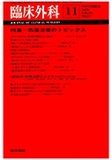Japanese
English
- 有料閲覧
- Abstract 文献概要
In the past few years there have been remarkable changes in the treatment of serious burn injuries.Mortality and morbidity have decreased;hospital stay has been shortened;and, perhaps most important of all from the patient's point of view, the functional and cosmetic results of burn treatment have strikingly improved. These improvements have been brought about not by a series of isolated advances but, for the most part, are related to two major developments in burn treatment: first, substantial control of burn wound sepsis in the initial two to three weeks following injury with the use of topical antibacterial agents; and second, the successful application of prompt excision of burn eschar and immediate wound closure with split thickness skin grafts as the primary form of treatment for patients with extensive burn injuries. This ability to excise and close the burn wound in the first few days after injury has brought the treatment of the burn wound to a level comparable with the effectiveness of immediate debridement of dead tissue and wound closure practiced so successfully for all other traumatic wounds. Although the application of these surgical principles to the extensively burned patient has not provided basic information leading to a solution of the septic, metabolic or organ failure problems seen so often as causes of death in burned patients, it has been successful in frequently avoiding them by early wound closure and restoration of the normal function of skin.
The idea of early primary excision and wound closure is not new but has been explored in the past without clinical success except for relatively small, well demarcated, full thickness burns. The recent practical success of these principles, it is important to add, is not based on new techniques of excision or grafting but on the extensive amount of physiologic information produced by basic and clinical research in the biologic sciences over the past 30 years. Armed with this information, it is possible to safely excise burn eschar of 70 or more percent of the body surface in staged operations and close the wound with viable autograft and allograft within the first week of injury. As a result, patients who have suffered deep burns to 80 or even 90 percent of their body survive today in ever increasing numbers. Hospital stay is now more often reckoned in terms of weeks as opposed to months for serious burns, and normal hand function is amost a certainty for all deep hand burns, except those where the initial thermal injury directly destroys tendons and joints. Early excision and the longterm use of pressure over the newly healed wound have greatly reduced the scar contracture and hypertrophic sear problems, and patients are able to return to work or school considerably earlier than in the past. This overall picture, therefore, is one of satisfaction for what has been accomplished and optimism for what will be possible in the future.
Copyright © 1979, Igaku-Shoin Ltd. All rights reserved.


